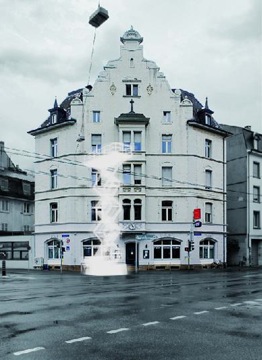
Rendering of "Ghost Notes, performance 1" (2009), Basel, Switzerland. Courtesy asiootus, Basel.
This past Sunday evening in Basel could have been like any other but it wasn’t. Not quite. My partner and I finished the strangely purple dinner I had crafted—beet pasta, plum tart—and rode our bikes over the Dreirosenbrücke, the wistfully named (and entirely rose-free) Three Roses Bridge that crosses the pewter-green Rhine into an industrial neighborhood of Northern Basel. There, at the dusk-darkened corner of Elsässerstrasse and Hueningerstrasse, we found ourselves watching a harpist perform from a precarious perch in the sky, just outside the fourth-story window of a pre-war building. The shadow of the harp loomed fairy-tale large against the building’s curvy façade. The delicate music—by Béla Bartòk, Benjamin Britten, John Cage, Erik Satie, and others—fell like water over the street. A man leaned out the window above the harpist, as enchanted as the audience leaning against their bicycles below. Mercy.
With the whirr of children and trams running by and streetlamps softly aglow, the bright, buoyant tones of the harp turned the entire street scene into just that: a scene. As the music moved from cheerful to sentimental to anticipatory to menacingly minimal, the now surreally cinematic street, totally ready for its close-up, morphed from a Fellini-esque comedy to a Nora Ephron romcom to a French Connection–like thriller to something far more noir. The scene was so wondrous it verged on the precious. Thankfully, the tall, boxy basket crane (itself recalling the scaffolding of film sets) that held the musician and her harp added some necessary levity, as did the costumes of the audience: flip-flops, beer cans, orange swimming bags (readers, it is August hot here).
Though I am no harp aficionado, my knowledge of the instrument limited to a twinned love for Alice Coltrane and Joanna Newsom, the music was wonderfully effecting; the harpist herself was Consuelo Giulianelli, a celebrated concert musician based in Basel. Her glittery performance inaugurated “Ghost Notes: Acoustic Still Lives at Voltaplatz in Basel,” a series of three site-specific performances over the next month. Curatorial duo asiootus (Baharak Tajbakhsh and André Freiermuth) helpfully articulated their intentions in the following text:
“Streets become loges, facades become scenes and the yard becomes a hall. The houses at the Voltaplatz sing. The block of flats at the corner of Hueningerstrasse and Elsässerstrasse in Basel opens its gates and windows for receiving Basel. Accompanied by harp sounds, choir voices and accordion we are shown the worlds of towns, which otherwise remain secret.”
The mutability— architectural and otherwise—the curators describe was immediately tangible in Giulianelli’s recital in the sky. The next two performances, comprising a local men’s choir (belting from windows) and a Ukrainian electronic accordionist playing a nearby backyard, should further the curators’ stated objectives: to transform a neighborhood into stage and performer both, and to highlight the latent theatricality in spaces public, private, and domestic. Turning a street into a “street scene,” which is itself based on the street, can recall the Ouroboros, the ancient symbol of the serpent devouring its own tail, but it can also shine a light on the ways in which we segregate our experiences and the spaces in which we have them. Art or the arts—visual, literary, musical, theatrical—are still often thought of as something apart from the actual business of living; that all is a performance is a truism that much contemporary art seeks to affirm. Without “breaking-the-third-wall” histrionics, the first “Ghost Notes” performance effortlessly turned its audience into extras, a building into a set, and an uncertain spot in the sky into a stage.

Poster for "Ghost Notes" (2009), Basel, Switzerland. Courtesy asiootus, Basel.
The title of the program is an actual musical term: “to ghost a note” (which could easily be Richard Price dialogue from The Wire, no?) is to nearly occlude it. On musical scores such notes are often set in parentheticals; muted as they are, they could be said to “haunt” the music at hand. Nevertheless, there was nothing specter-like about Giulianelli’s performance—her notes rang true and clear except when muffled by the street’s own sonic interludes—but for its placement in the netherworld between street and sky. Not bad for a simmering Sunday night in Switzerland.
Coda: As is the case with many of the most au courant contemporary art and performance offerings to be had in Basel since I moved here last winter, “Ghost Notes” is funded by Nordtangente-Kunsttangente, a public arts directive led by brilliant local curator and impresario Daniel Baumann (director of local gallery New Jerseyy, and curator of a recent summer show of Georgian Modernism at Casey Kaplan, New York). The Nordtangete is the international highway in Northern Basel that connects Germany and France with Switzerland; the decades-long project has turned much of the neighborhood into a construction site. Accordingly, Nordtangente-Kunsttangente aims to revitalize the area via public art projects and interventions, moving the emphasis from cranes and scaffolding to culture and the people who make it. In this regard, “Ghost Notes” is a perfect project: shining a light on the neighborhood’s domestic spaces by turning them into platforms for performance—and into performers themselves.




Pingback: Ghost That Note: Harpstrings, Heartstrings, and Street Scenes « Fire EXIT